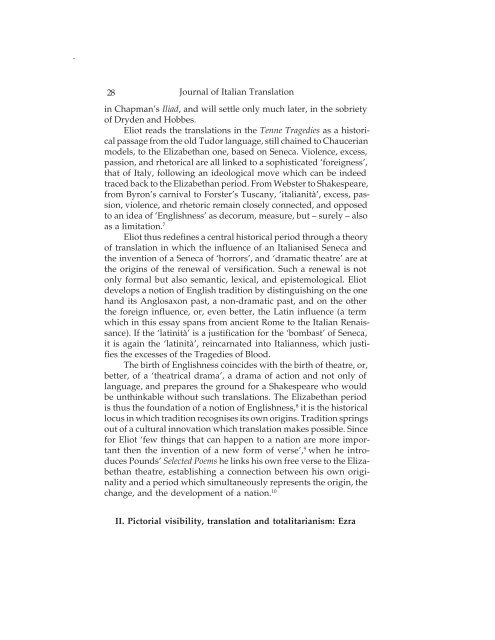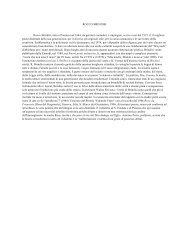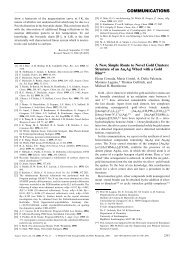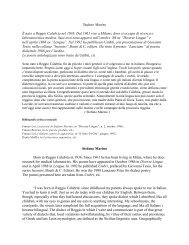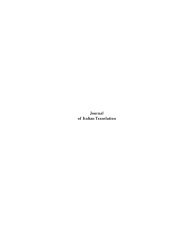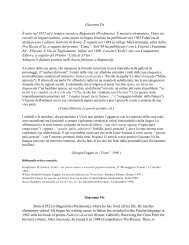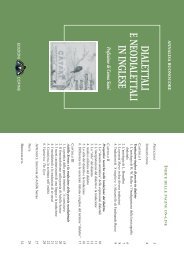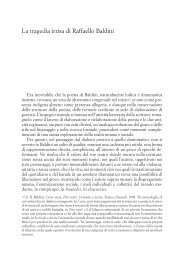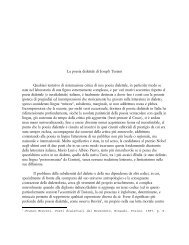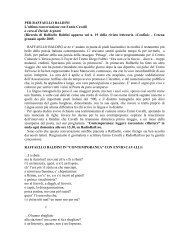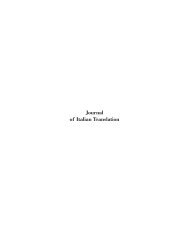Journal of Italian Translation
Journal of Italian Translation
Journal of Italian Translation
Create successful ePaper yourself
Turn your PDF publications into a flip-book with our unique Google optimized e-Paper software.
28 <strong>Journal</strong> <strong>of</strong> <strong>Italian</strong> <strong>Translation</strong><br />
in Chapman’s Iliad, and will settle only much later, in the sobriety<br />
<strong>of</strong> Dryden and Hobbes.<br />
Eliot reads the translations in the Tenne Tragedies as a historical<br />
passage from the old Tudor language, still chained to Chaucerian<br />
models, to the Elizabethan one, based on Seneca. Violence, excess,<br />
passion, and rhetorical are all linked to a sophisticated ‘foreigness’,<br />
that <strong>of</strong> Italy, following an ideological move which can be indeed<br />
traced back to the Elizabethan period. From Webster to Shakespeare,<br />
from Byron’s carnival to Forster’s Tuscany, ‘italianità’, excess, passion,<br />
violence, and rhetoric remain closely connected, and opposed<br />
to an idea <strong>of</strong> ‘Englishness’ as decorum, measure, but – surely – also<br />
as a limitation. 7<br />
Eliot thus redefines a central historical period through a theory<br />
<strong>of</strong> translation in which the influence <strong>of</strong> an <strong>Italian</strong>ised Seneca and<br />
the invention <strong>of</strong> a Seneca <strong>of</strong> ‘horrors’, and ‘dramatic theatre’ are at<br />
the origins <strong>of</strong> the renewal <strong>of</strong> versification. Such a renewal is not<br />
only formal but also semantic, lexical, and epistemological. Eliot<br />
develops a notion <strong>of</strong> English tradition by distinguishing on the one<br />
hand its Anglosaxon past, a non-dramatic past, and on the other<br />
the foreign influence, or, even better, the Latin influence (a term<br />
which in this essay spans from ancient Rome to the <strong>Italian</strong> Renaissance).<br />
If the ‘latinità’ is a justification for the ‘bombast’ <strong>of</strong> Seneca,<br />
it is again the ‘latinità’, reincarnated into <strong>Italian</strong>ness, which justifies<br />
the excesses <strong>of</strong> the Tragedies <strong>of</strong> Blood.<br />
The birth <strong>of</strong> Englishness coincides with the birth <strong>of</strong> theatre, or,<br />
better, <strong>of</strong> a ‘theatrical drama’, a drama <strong>of</strong> action and not only <strong>of</strong><br />
language, and prepares the ground for a Shakespeare who would<br />
be unthinkable without such translations. The Elizabethan period<br />
is thus the foundation <strong>of</strong> a notion <strong>of</strong> Englishness, 8 it is the historical<br />
locus in which tradition recognises its own origins. Tradition springs<br />
out <strong>of</strong> a cultural innovation which translation makes possible. Since<br />
for Eliot ‘few things that can happen to a nation are more important<br />
then the invention <strong>of</strong> a new form <strong>of</strong> verse’, 9 when he introduces<br />
Pounds’ Selected Poems he links his own free verse to the Elizabethan<br />
theatre, establishing a connection between his own originality<br />
and a period which simultaneously represents the origin, the<br />
change, and the development <strong>of</strong> a nation. 10<br />
II. Pictorial visibility, translation and totalitarianism: Ezra


